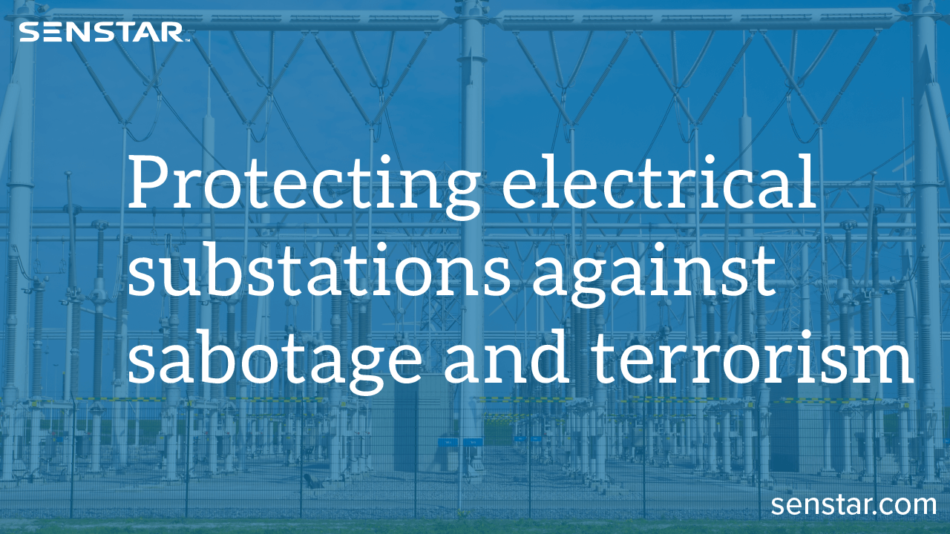Protecting Electrical Substations Against Sabotage and Terrorism

Recent events in the U.S., specifically North Carolina, Oregon, Nevada, and Washington have unfortunately shown the risks posed to electrical infrastructure by extremists or those seeking to use power outages as distractions for other illegal activities. Senstar, with its in-depth industry knowledge, comprehensive product portfolio, and new technology innovations, can help secure electrical sites with solutions that enable situational awareness and offer the highest level of security, all while defeating nuisance alarms once and for all.
The need to improve the security of North America’s electrical infrastructure is clear – the multiple, targeted attacks led to widespread, multi-day power outages, affecting tens of thousands of customers as temperatures plunged to near or below freezing and forcing schools and businesses to close. While the methods of the attacks varied, and key facts remain unknown at this time, the vulnerability of “soft targets” like electrical sites to vandalism, sabotage, and terrorist attacks is undisputed. These attacks are not new, one-off, or isolated incidents – targeted attacks against electrical infrastructure have occurred previously, with the 2013 sniper attack in California being the most high-profile.
Clearly, actions need to be taken, both now and in the long term. Implementing real, effective solutions will require close partnerships among electrical operators, law enforcement organizations, government, and the physical security industry.
How Senstar Can Help Prevent Attacks
Senstar, with its comprehensive portfolio of perimeter intrusion detection sensors and solutions combining video management software, video analytics, access control, and data intelligence, has extensive experience helping electrical utility operators in the U.S. and around the world in the design and deployment of physical security solutions that meet their individual requirements. With the consequences of an attack being so severe, it is critical that utility operators are notified of potential threats as early as possible; however, at the same time, security staff need to avoid the distractions, information overload, and resulting system mistrust caused by systems that generate false or nuisance alarms. The operational concerns of false and nuisance alarms in high security applications directly affect the scalability of current security technologies (including but not limited to fence sensors, radar, LIDAR, and video analytic based solutions) when deployed at remote, geographically distributed sites like substations.

Remote substations pose substantial security challenges – security technologies must be able to detect threats as early as possible while balancing the generation of false or nuisance alarms caused by the detection of nearby non-threat activity
To better address the needs of electrical utilities, Senstar has made substantial investments in the research and development of new security approaches and has worked closely with customers to defeat nuisance alarms once and for all. Senstar’s new Sensor Fusion Engine, for example, is a breakthrough technology and unique in the industry – synthesizing data from separate systems to generate actionable information. In real-world deployments, the Sensor Fusion Engine has demonstrated the ability to virtually eliminate nuisance alarms while continuing to detect sophisticated attacks, ones potentially missed by other technologies. At the same time, Senstar continues in its goal to address industry concerns by developing next-generation solutions that can detect an even wider range of threats.
Existing Regulations and Upcoming Changes
In the longer term, the increase in threats to electrical infrastructure will inevitably lead to renewed rigor with respect to government-imposed regulations.
In 2014, the Federal Energy Regulatory Commission (FERC) directed the North American Electric Reliability Corporation (NERC) to devise a set of standards covering security and operation for bulk power operators, with CIP-014 being specific to physical security (NERC CIP-014 R5 mandates that operators implement physical security measures designed to collectively Deter, Detect, Delay, Assess, Communicate, and Respond to potential threats and vulnerabilities).
In light of the threats and risks shown by recent events, FERC ordered NERC to re-assess the effectiveness of this physical security standard . This renewed focus on existing, expanded, and new regulations related to physical security for electrical stations, substations, control centers, and associated critical infrastructure will be a major concern in 2023 and beyond.
Download Senstar’s Physical Security Guide
To assist operators and security experts in securing electrical infrastructure, Senstar has prepared an application guide that outlines our security solutions related to measures designed to deter, delay, assess, communicate, and respond to potential physical threats and vulnerabilities identified during site security evaluations:


